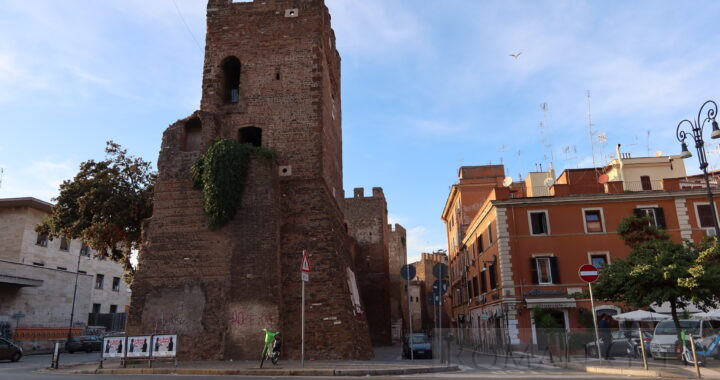- The Aurelian Walls encircled Rome and were completed between 270-275 CE by the Emperor Aurelian in response to the rising threat of Germanic Invasions.
- Two thirds of the Wall are still standing, after one third was dismantled in 545 CE by the king of the Ostrogoths, Totila.
Getting There
- The Walls may be viewed from a number of locations:
- Castra Praetoria
- The Via del Policlinico runs along the perimeter of the original walls of the Castra Praetoria, which were included into the Aurelian Walls.
- Piazzale Tiburtino
- A well-preserved section of the Aurelian Walls then continues along the Via di Porta S. Lorenzo and Via di Porta Labicana. A gap in the Walls has been created for the modern Via Tiburtino to pass through at the Piazzale Tiburtina.
- Pyramid of Cestius.
- This was incorporated into the Wall next to a gate known as the Porta San Paolo which was the start of the Via Ostiense to Ostia.
- Piazza del Popolo
- This famous square lies in front of the Porta del Populo in the Aurelian Walls and was originally the Porta Flaminia, the start of the Via Flaminia to Rimini. The Flaminio Obelisk stands in the Square.
- Porta San Sebastiano
- A well-preserved section of the Wall with towers runs along the Viale di Porta San Sebastiano between the Porta San Sebastiano and the Porta Ardeatina.
- Castra Praetoria
Rome’s first Wall (4th century BCE)
- The first wall around Rome was the Servian Wall built in fourth century BCE.
- Rome eventually outgrew these walls and the Aurelian Walls were a built as a second perimeter in 275 CE.
Construction of the Aurelian Walls (270-275 CE)
- Built in 5 years between 270-275 CE by Aurelian.
- They were 12 miles (20km) long and had 14 Gates. By the 4th century CE it had 18 gates and 383 towers.
- The walls were 26 ft (8m) high and constructed from tiled bricks and concrete.
- To save time and money, up to one sixth of the walls were built into existing monuments such as the Pyramid of Cestius, the Castra Praetoria, part of the Aqua Claudia Aqueduct and the Amphitheatrum Castrense.
The Reason for a new wall
- Rome’s first wall was the Servian Wall, but Rome had expanded greatly since the building of this original defensive wall. Built in the 4th century BCE with 16 gates, it no longer encircled the expanded city. Rome now needed a new defensive perimeter to hold off attackers.
- The Aurelian Walls were built during the Crisis of the Third Century, when the Armies of the Germanic Tribes entered Italia in 270 CE and reached Piacenza before being repulsed.
- Aurelian built the Walls in response, as Rome had no walled outer perimeter since the city had not been attacked for several centuries.
Later improvements (306-401 CE)
- Maxentius (306-312 CE) doubled the height of the Walls.
- Honorius in 401 CE added further improvements, and converted Hadrian’s Mausoleum, the Castel San Angelo, into a defensive fortress.
Destruction (545 CE)
- Totila, King of the Ostrogoths, in 545 CE dismantled one third of the walls, to prevent the Eastern Empire from defending it against the Gothic Invasions.
Photo and Map: Aurelian Walls at Piazzale Tiburtino

